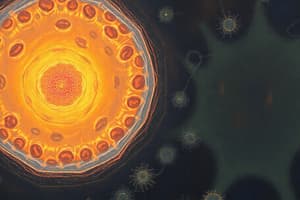Podcast
Questions and Answers
What is the main function of the Golgi apparatus in eukaryotic cells?
What is the main function of the Golgi apparatus in eukaryotic cells?
- Modifying, sorting, and packaging proteins and lipids (correct)
- Producing energy
- Breaking down waste materials
- Storing genetic material
Which organelle is the site of protein synthesis and folding in eukaryotic cells?
Which organelle is the site of protein synthesis and folding in eukaryotic cells?
- Lysosomes
- Endoplasmic reticulum (correct)
- Mitochondria
- Nucleus
What is the function of peroxisomes in eukaryotic cells?
What is the function of peroxisomes in eukaryotic cells?
- Produces energy
- Catabolizes fatty acids and detoxifies harmful substances (correct)
- Breaks down waste materials
- Modifying genetic material
Which organelle is responsible for maintaining homeostasis by regulating the flow of substances in and out of the cell?
Which organelle is responsible for maintaining homeostasis by regulating the flow of substances in and out of the cell?
What is the primary function of lysosomes in eukaryotic cells?
What is the primary function of lysosomes in eukaryotic cells?
Which organelle produces energy through cellular respiration in eukaryotic cells?
Which organelle produces energy through cellular respiration in eukaryotic cells?
What is a defining characteristic of prokaryotic cells?
What is a defining characteristic of prokaryotic cells?
Where is the genetic material located in prokaryotic cells?
Where is the genetic material located in prokaryotic cells?
Which organelle is responsible for protein synthesis in cells?
Which organelle is responsible for protein synthesis in cells?
What is a common feature of eukaryotic cells that distinguishes them from prokaryotic cells?
What is a common feature of eukaryotic cells that distinguishes them from prokaryotic cells?
Which type of cells can be classified as either plant or animal?
Which type of cells can be classified as either plant or animal?
Which structures in prokaryotic cells are involved in cell motility and movement?
Which structures in prokaryotic cells are involved in cell motility and movement?
Study Notes
Cell Structure
Cells are the basic units of life. They are composed of a variety of organelles, each performing specific functions necessary for the cell's survival and proper function. Understanding cell structure is crucial to understanding how cells operate and how they contribute to the overall functioning of living organisms. There are two main types of cells: prokaryotic and eukaryotic. Let's explore the structure of both types of cells.
Prokaryotic Cells
Prokaryotes are simpler cells that lack a membrane-bound nucleus. Examples of prokaryotes include bacteria and archaea. Their cell structure is relatively straightforward. Prokaryotic cells typically contain the following organelles:
- Nucleoid: A region within the cell where genetic material, DNA, is located. Unlike eukaryotic cells, prokaryotic cells do not have a separate membrane-bound nucleus.
- Ribosomes: Protein synthesis occurs here, carrying out translation, one of the steps in the central dogma of molecular biology.
- Flagella and pili: Structures involved in cell motility and movement.
Eukaryotic Cells
Eukaryotes, on the other hand, have a more complex cell structure due to their membrane-bound nucleus and other organelles. Eukaryotic cells can be categorized into two groups based on their mode of reproduction: plant and animal. Both groups share common organelles, but there are differences between them as well. Here are some of the notable organelles found in eukaryotic cells:
- Plasma membrane: Regulates the flow of substances in and out of the cell, maintaining homeostasis.
- Endoplasmic reticulum (ER): Site of protein synthesis and folding, as well as lipid synthesis.
- Golgi apparatus: Responsible for modifying, sorting, and packaging proteins and lipids.
- Nucleus: Contains genetic material and controls the cell's activities.
- Mitochondria: Produces energy through cellular respiration.
- Lysosomes: Breaks down waste materials within the cell.
- Peroxisomes: Catabolizes fatty acids and detoxifies harmful substances.
While the exact arrangement and number of organelles may differ between plant and animals cells, the principles remain consistent. Both types of cells rely on a diverse array of organelles to perform a wide range of essential processes.
In summary, cells, whether prokaryotic or eukaryotic, exhibit a rich and fascinating structure that allows them to carry out the critical tasks required for life. Understanding cell structure is essential for gaining insights into the inner workings of cells and the processes that sustain life.
Studying That Suits You
Use AI to generate personalized quizzes and flashcards to suit your learning preferences.
Description
Explore the structures and organelles of prokaryotic and eukaryotic cells. Learn about the unique features of each type of cell, including the functions of key organelles like the nucleus, mitochondria, and ribosomes.



